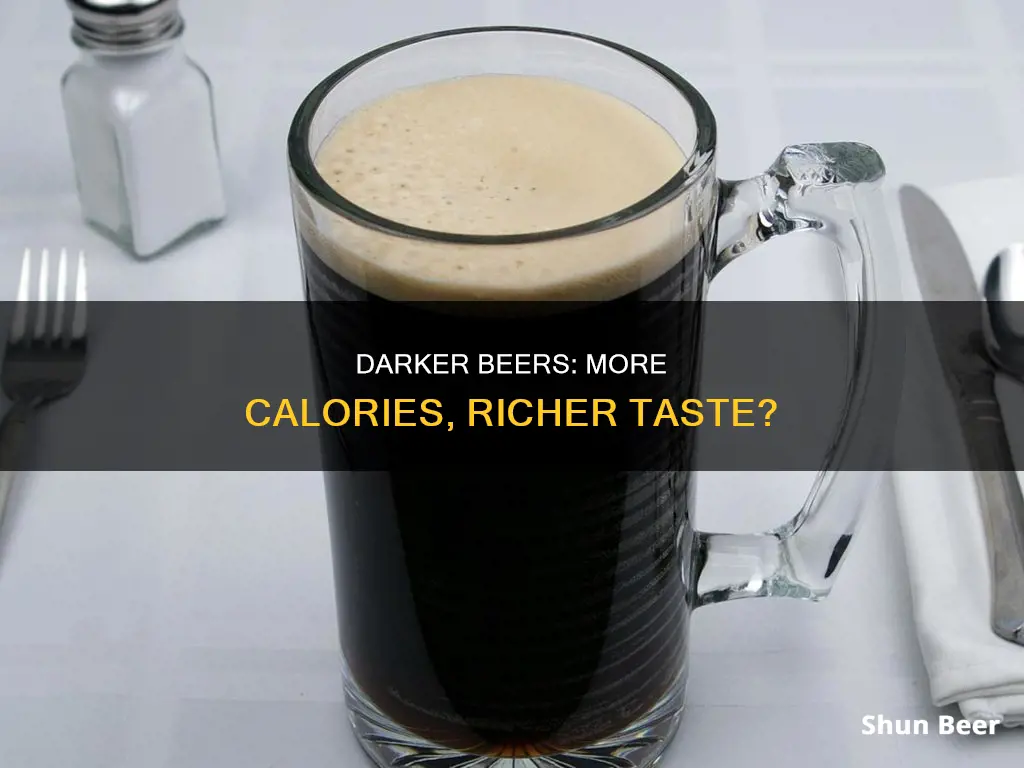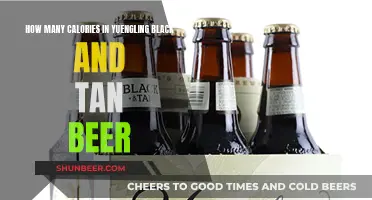
It is a common misconception that darker beers are higher in calories. In reality, the number of calories in a beer is directly related to its alcohol content, which is determined by factors such as the type of yeast used and the amount of maltose present, rather than by its colour. Darker beers are often assumed to be heavier and richer, but this is not always the case. In fact, some dark beers, such as stouts and porters, can have a lower alcohol content and, therefore, fewer calories than lighter beers.
What You'll Learn

Dark beers are not always higher in calories
It is a common misconception that dark beers are heavier, richer, and higher in alcohol and calorie content. While this is often the case, it is not always true.
The colour of beer is directly related to its malt content. The fermentable sugar in most craft beers comes from malted barley that has been germinated and kilned. Additional colour and malt flavour are achieved through the roasting process. Light roasted malts yield straw and golden colours and biscuit flavours, while darker roasts produce brown and light black colours, with chocolate and coffee flavours. The heaviest roasts result in black colours and burnt flavours.
However, the colour of a beer does not determine its alcohol content. Stouts, porters, and black lagers that hover in the range of four to five per cent alcohol by volume can have less alcohol and calories than a light pilsner. For example, a serving of Guinness has 125 calories, while a Bud Light has 110 calories. Similarly, a Samuel Adams Black Lager, a light-bodied beer with a mere 4.9 per cent ABV, has under 200 calories in a 12-oz serving. In contrast, a highly pale beer such as the Golden Monkey has a whopping 9.5 per cent ABV and is estimated to have over 300 calories in a 12-oz serving.
The calories in beer come from the alcohol content and the residual carbohydrates. The colour of the malt does not affect the alcohol content, and the colour alone does not account for the residual carbohydrates in the finished beer. Black lagers, porters, and drier stouts do not have remarkably high calories in comparison to pale beers.
Calories in Carlton Draft Beer: What's the Count?
You may want to see also

Calories in beer are directly correlated with alcohol content
It is a common misconception that darker beers are higher in calories. While this is not entirely wrong, it is not always the case. The colour of a beer has no direct relation to its alcohol content or calorie count.
The calories in beer come from two sources: alcohol content and residual carbohydrates. The higher the alcohol by volume, the higher the calories. However, the colour of the malt does not affect the alcohol content or the residual carbohydrates in the finished beer. For example, black lagers, porters, and drier stouts do not have remarkably high calories compared to pale beers. In fact, a light pilsner can have more alcohol and calories than a stout or porter.
The colour of beer is directly related to its malt content. The fermentable sugar in most craft beers comes from malted barley that has been roasted. The roasting process also adds colour and malt flavour. Lighter roasts yield straw and golden colours, while darker roasts produce brown and light black colours with hints of chocolate and coffee flavours. Heavier roasts result in black colours and burnt flavours.
When it comes to dark malts, a small amount goes a long way. Dark malts typically make up only 1-5% of the overall recipe, while craft beers are made up of 75-100% base malts, the palest malts on the spectrum. Therefore, the colour of a beer is not an accurate indicator of its calorie content or alcohol volume. It is a myth that darker beers are always heavier, richer, and higher in alcohol and calories.
Calories in Beer: DockSider's Nutritional Breakdown
You may want to see also

Darker beers are not always heavier
Darker beers are often perceived as heavy and rich, with high alcohol content and calories. However, this is not always the case. While it is true that darker beers are made from heavily roasted grains, it is a common myth that the colour of a beer is directly related to its weight, alcohol content, or calorie count.
The colour of beer is determined by the malt content and the grains used in the brewing process. Darker beers come from grains that have been heavily roasted, while lighter beers are made from grains that have been gently toasted. The degree of roasting does not affect the alcohol content or calorie count of the beer. In fact, the colour of a beer has no direct relation to its alcohol content. Variables that do impact alcohol content include rice, corn, sugar, and malt. For example, Guinness, a dark beer, has only 4.2% ABV, while the extremely pale Golden Monkey has 9.5% ABV.
The calories in beer come from two sources: the alcohol content and the residual carbohydrates. Since the colour of a beer does not affect its alcohol content or the residual carbohydrates, it is a myth that darker beers are higher in calories. Black lagers, porters, and dry stouts are often lower in calories than light beers. For example, a 12-oz serving of Guinness has 125 calories, while a Bud Light has 110 calories.
So, if you're looking for a light beer that won't sabotage your diet, don't be afraid to try a darker option. Judge a beer by its alcohol content, not its colour, if you're looking for something light on calories, alcohol, and density.
Calorie Count in Miller High Life Beer
You may want to see also

The colour of beer is related to malt content
The degree to which grains are roasted impacts the final colour of a beer. In general, the longer a grain is roasted, the richer and darker the resulting brew. However, it is a common misconception that darker beers are higher in alcohol and calories. While darker beers are often higher in alcohol and calories, it is not always the case. The colour of a beer has no direct relation to its alcohol content.
The calories in beer come from the alcohol content and the residual carbohydrates. The higher the alcohol by volume, the higher the calories. However, the colour of the malt does not affect the alcohol content. Black lagers, porters, and drier stouts do not have remarkably high calories in comparison to pale beers. For example, a light-bodied Samuel Adams Black Lager, with 4.9% ABV, has under 200 calories in a 12-oz serving. In contrast, a highly carbonated, extremely pale Golden Monkey has a 9.5% ABV and over 300 calories in a 12-oz serving.
Calorie Count in Harp Beer: Nutritional Facts Explained
You may want to see also

Darker beers do not always have more alcohol
It is a common misconception that darker beers are higher in alcohol content. While this is often the case, it is not always true. The colour of a beer has no direct relation to its alcohol content.
The colour of beer is directly related to its malt content. The fermentable sugar in most craft beer comes from malted barley that has been germinated and kilned. Additional colour and malt flavour come from the roasting process. Light roasted malts yield straw and golden colours and biscuit flavours, while darker roasts produce brown and light black colours, with chocolate and coffee flavours. The heaviest roasts yield black colours and burnt flavours.
However, the colour of the malt does not affect the alcohol content. Yeast metabolises sugars that it extracts from the malt content, which produces alcohol (and CO2). So, whether a beer calls for a dark malt or a very pale one, the yeast will metabolise sugar and produce alcohol. For example, Guinness is a black beer with only 4.2% ABV, while the extremely pale Golden Monkey has a much higher ABV of 9.5%.
The calories in beer come from the alcohol content and the residual carbohydrates. Therefore, the higher the alcohol content, the higher the calories. So, while darker beers may sometimes have more alcohol, this is not always the case, and the colour of the beer is not an indicator of its alcohol content.
Calories in a Clamato Beer: Nutritional Facts Revealed
You may want to see also
Frequently asked questions
No, the colour of a beer does not determine its calorie content. The number of calories in a beer is directly related to its alcohol content and its residual carbohydrates.
The calorie content of beer is determined by its alcohol content and its residual carbohydrates.
Not necessarily. The colour of a beer is not directly related to its alcohol content. The alcohol content of a beer is influenced by factors such as rice, corn, sugar, and malt content.
Yes, some dark beers have fewer calories than light beers. For example, a serving of Guinness has 125 calories, while a Bud Light has 110 calories. Other low-calorie dark beers include black lagers, porters, and dry stouts, which typically have an ABV of around 4-5%.







